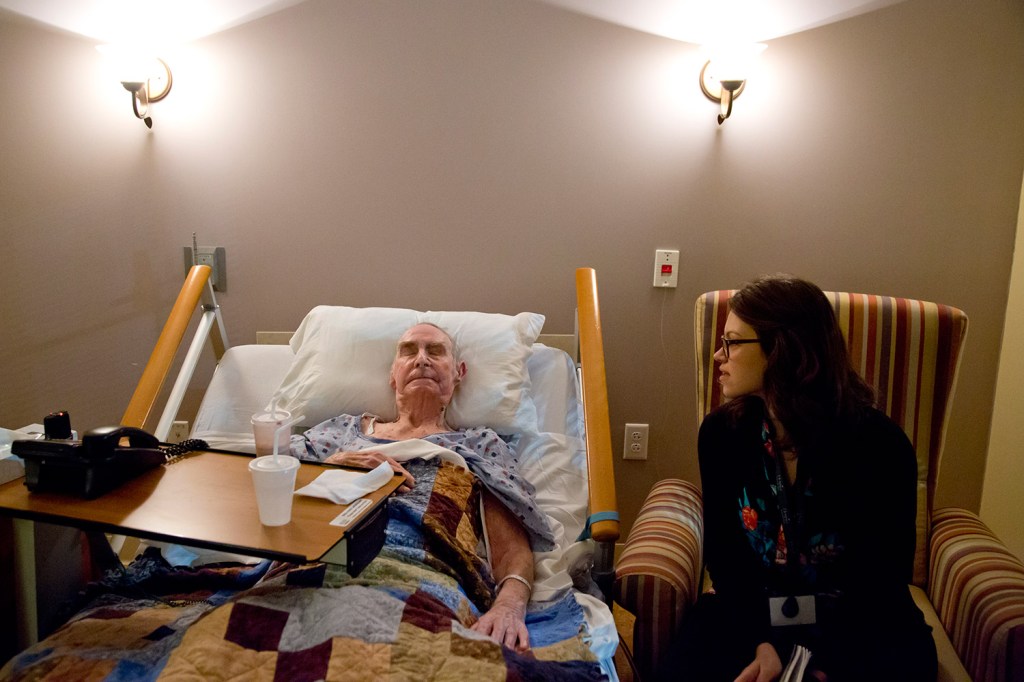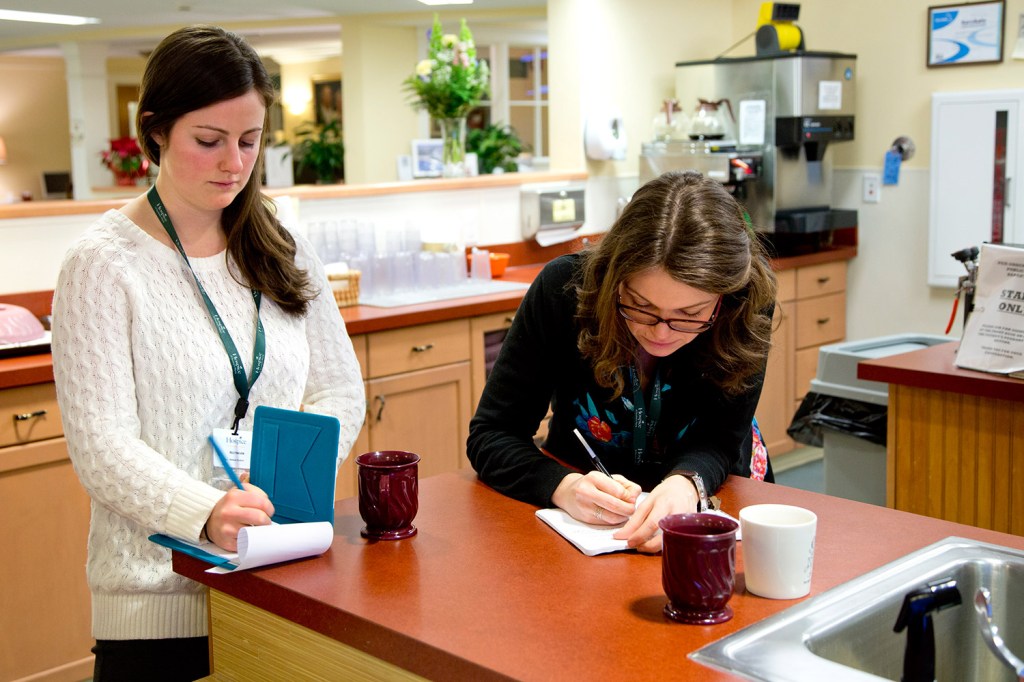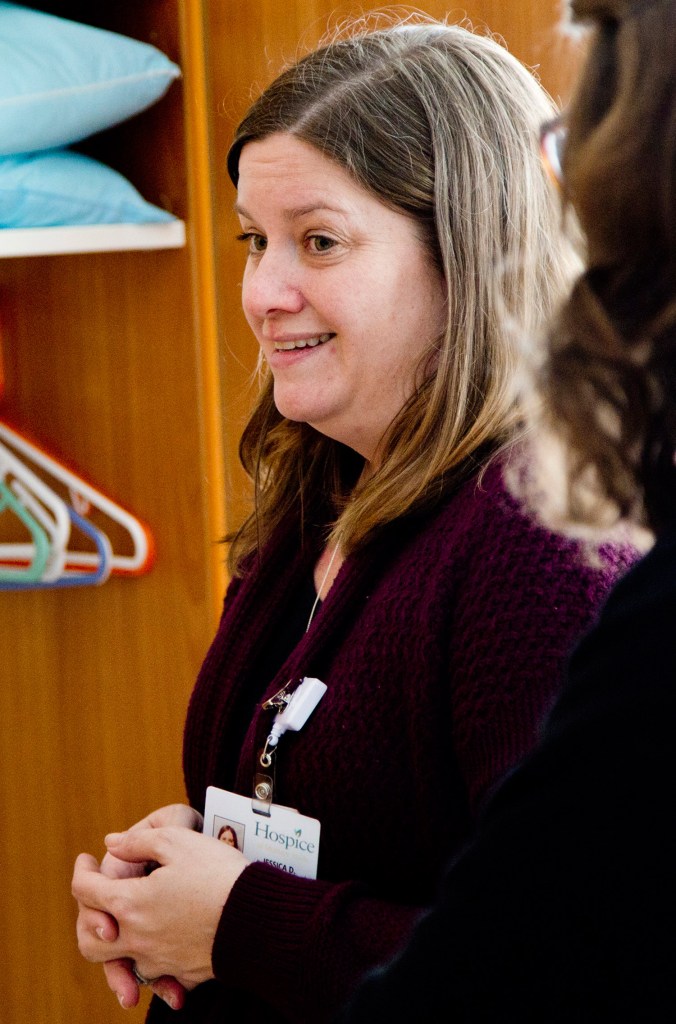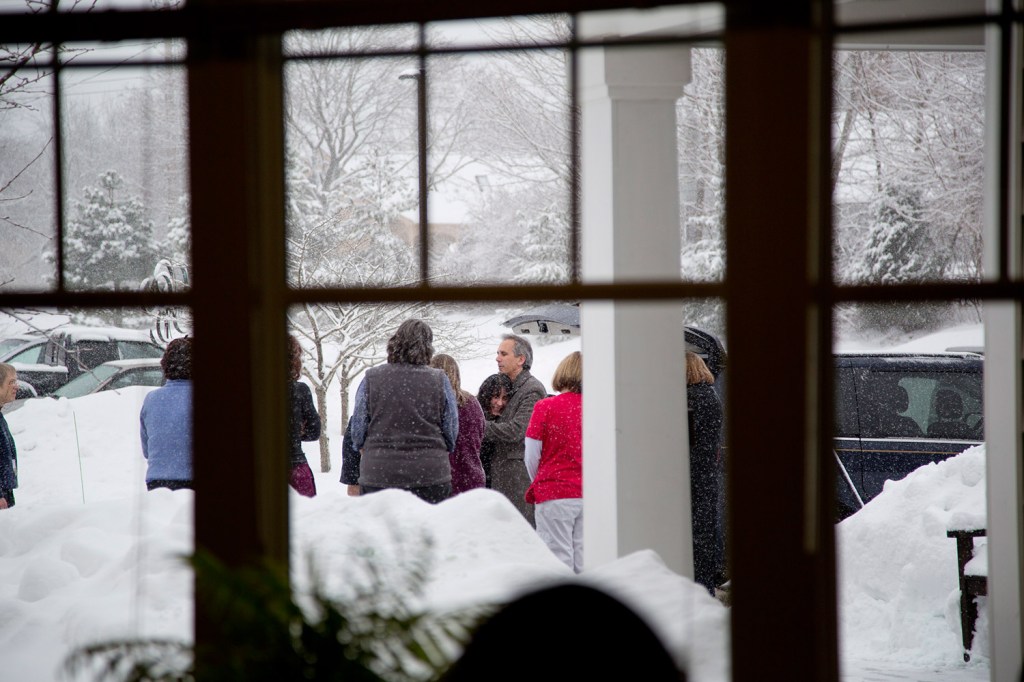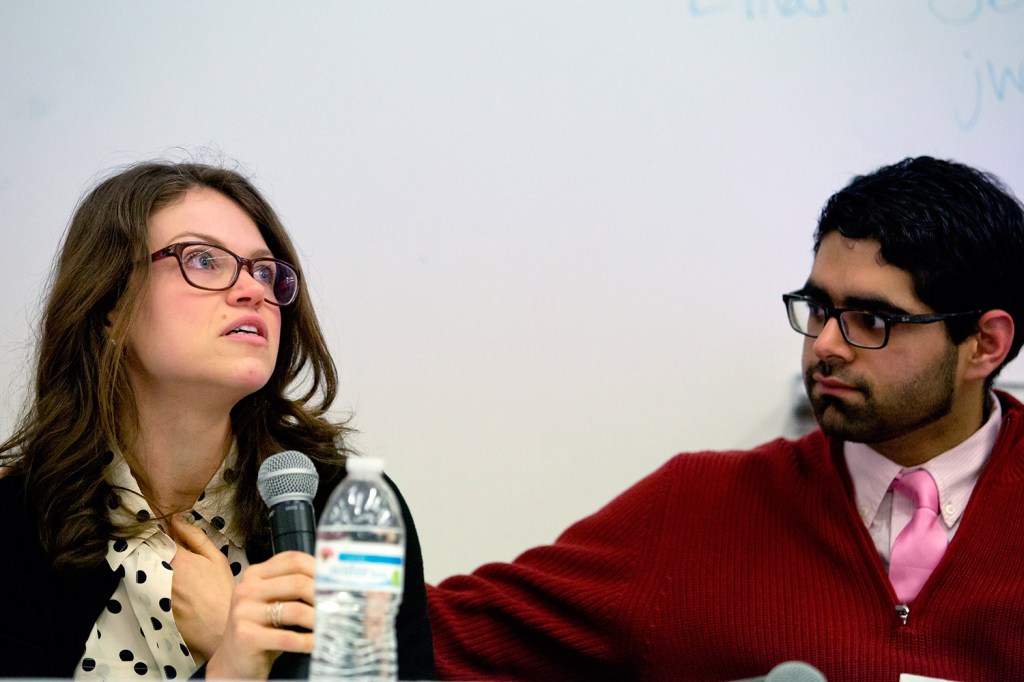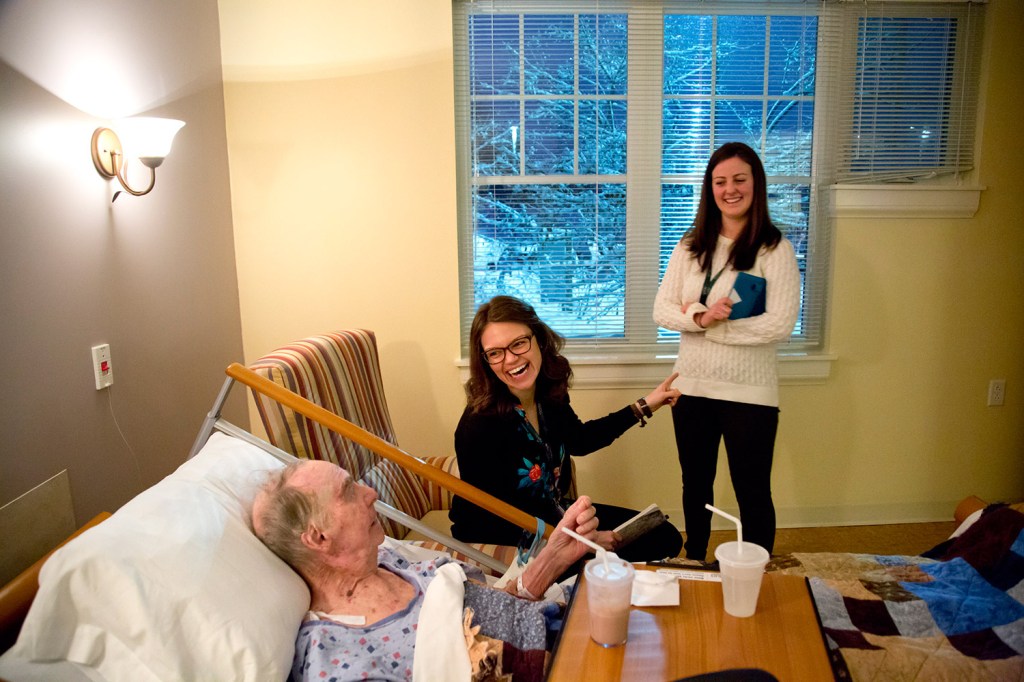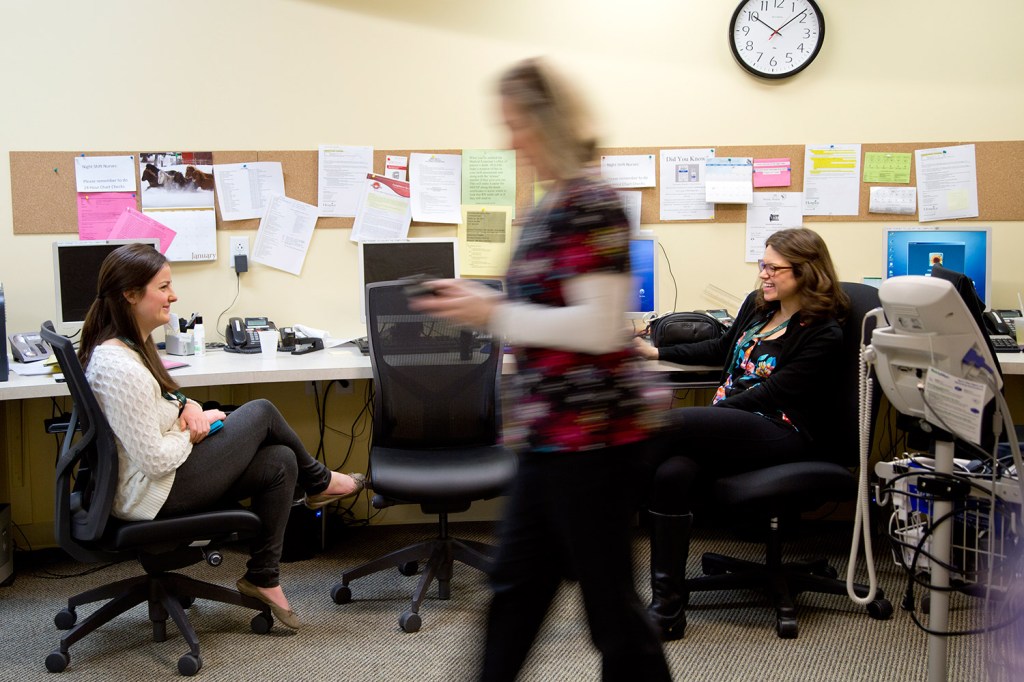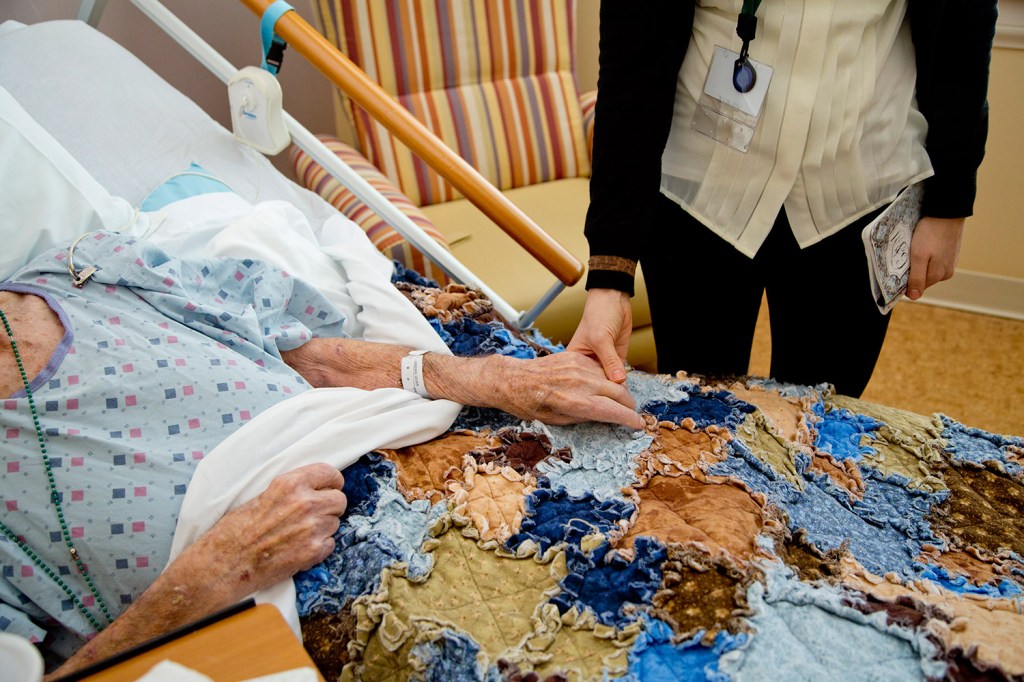SCARBOROUGH — Kelly McVan and Caitlyn Farrell got an early glimpse of what they would experience over the next 48 hours.
Soon after arriving at Gosnell Memorial Hospice House for a rare educational experience, the two University of New England medical students sat by a window and witnessed a deceased patient being removed from the facility by a funeral director.
Several hospice staff members lined the snowy walkway as the body was wheeled out to a dark hearse. They hugged the patient’s loved ones and said goodbye. Some staff members wiped away tears.
It was an unexpected and emotional moment for the two young med students, watching quietly during their orientation in a small conference room. They would see the farewell ritual repeated a few times over the next two days.
“It is really powerful,” said McVan, 24, who is from the Philadelphia area. “It’s so meaningful and respectful for each person.”
McVan and Farrell are among four students in UNE’s College of Osteopathic Medicine in Biddeford who, at their own request, spent recent weekends living and working at the home for terminally ill patients. The pilot Hospice Immersion Project provided unique exposure to end-of-life care in a nation whose medical schools are giving short shrift or largely ignoring a growing demand for training in long-term, palliative and hospice care. It also was an intense introduction to the realities of dying and death for students on the cusp of becoming physicians.
Admitted in pairs, the second-year med students spent two days learning from hospice staff and helping to care for patients and their families. They stayed in suites where people had died and their loved ones mourned. They followed nurses and physicians on their rounds and journaled about what they saw and heard. They got to know patients and their families and learned what it takes to care for people in their final hours.
McVan and Farrell were at Gosnell House in January, following Andrea Gaul and Himanshu Malhotra in early December.
Gaul, 26, a native of Buffalo, New York, came away with a deeper understanding of the basic goals of hospice care, which are to limit patients’ suffering and to celebrate their lives.
“I was surprised how uplifting it was,” Gaul said. “Of course it was sad, witnessing the loss of each patient, but it also was a celebration of each patient’s life. The communication and the energy that each nurse and physician brought to each patient was amazing. It was beautiful to see.”
The pilot hospice experience was so positive, for both the med students and the hospice staff, that UNE plans to make the Hospice Immersion Project a regular offering to several students each year and hopes to expand it to other hospice providers, said Dr. Douglas Wood, dean of the college.
“It’s a marvelous thing to have students involved in this kind of educational adventure,” Wood said. “Dying is part of the living experience, yet I think these students learned more in 48 hours than most students do throughout medical school and residency.”
DESIRE TO LEARN
Gaul and her fellow students recognized early on that there was a dearth of hands-on hospice training in their courses.
“It’s something we’re definitely lacking in our medical school experience,” Gaul said. “It’s something no one talks about much, beyond diagnosis and treatment, and ultimately we’re all going to have patients who die. I’m kinda nervous about that and I wanted to have some experience with it.”
They reached out to Marilyn Gugliucci, Ph.D., head of geriatric education and research at the college. Gugliucci got the OK from Gosnell House and modeled the hospice immersion program after her Learning by Living Project, which allows students to spend two weeks as a nursing home resident.
Gugliucci has written an article about the Hospice Immersion Project, co-authored by Gaul and Malhotra, to be published this month in a special issue of the Journal of International Clinical Medicine dedicated to palliative and hospice care.
Gugliucci found that the immersion experience humanized death for the students and solidified their realization that dying is part of life. The students found honor in a process that alleviates pain, increases comfort and values communication and human connections, she wrote. And they learned the importance of physical touch and sincerity when interacting with patients, so that even silence can communicate caring.
It’s the kind of firsthand experience that few med students get, despite increasing demand for hospice care by terminal patients of all ages and a growing senior population nationwide, according to Gugliucci’s journal article.
“Traditional medical education methods rarely include visits to hospice homes, much less provide bedside approaches to end-of-life care,” Gugliucci wrote. “Medical student training and experiences in hospice, palliative, and end-of-life care are often viewed as incomplete. Time is short and experiences are superficial as each experience may last for only a few hours and occur rarely.”
DIFFICULT LESSONS
Staff members at Gosnell House appreciated having the UNE students in their midst and sharing their knowledge of end-of-life care, said Jessica Duffy, house director. Based on their own experiences as hospice providers, many staff members anticipated and noticed a transformation in each student.
“You’ll be changed,” Duffy told McVan and Farrell during their orientation. “You’re going to be subjected to this experience you’ve never had before, just like I was. Whoever you have that experience with, it never, ever leaves you. It’s good work, so I encourage you to lap it up.”
Both Farrell and McVan were eager to learn, but they were concerned about remaining professional in highly emotional situations.
“I’m nervous,” Farrell, 27, said as her immersion began in January. “I don’t know how it’s going to be when someone dies. I don’t know how I’m going to react. I don’t want to be unprofessional. I feel better because it’s such a comfortable place and everybody is so nice.”
The students got to know and said goodbye to several patients during their immersions. Encounters with younger patients were unexpectedly hard to bear.
“I don’t think I was prepared to see him brought in,” McVan said, recalling one young man’s admission. “I found myself tearing up and I had to leave the room and I’m not really sure why.”
Caring for older patients was no easier. McVan and Farrell spent several hours at one patient’s bedside, only to learn that she died shortly after they left to take a short nap.
“I felt bad that we weren’t there,” McVan said, “but the nurse said sometimes they wait until no one is there.”
McVan and Farrell developed a close connection with 90-year-old Selden “Bud” Crocker of Arundel, who was admitted to Gosnell House for a brief stay before being transferred to a long-term care facility. Some patients have short stays at the hospice house to get symptoms under control or to relieve family caregivers.
McVan and Farrell often stopped by Crocker’s room to chat, hold his hand, hear his stories about golfing and playing piano, and anticipate seeing the Patriots win the Super Bowl.
“I’m gonna miss you girls,” Crocker said as their immersion ended. “It’s been a blessing just having you here for this short time.”
A BETTER ALTERNATIVE
In February, Malhotra and Farrell shared their experiences at Gosnell House in a UNE auditorium filled with more than 170 second-year med students. They also shared their more personal experiences with the deaths of family members who didn’t have hospice care.
Malhotra, who is from Toronto, learned the true value of hospice soon after his immersion in December.
During the holiday break that followed, Malhotra traveled to India, where his grandmother lay dying after a stroke. His uncle and aunt, both physicians, were caring for his grandmother at home without the benefit of hospice support.
As her condition improved and declined, they remained focused on restoring her health. Malhotra helped as he could, respectful of his elders. His grandmother died Jan. 1, shortly after he returned to Maine.
“There was no hospice to help them understand what was happening,” said Malhotra, 24. “They never accepted that my grandma was dying. I realized the importance of hospice because they were so close to the situation, they weren’t able to grieve. Hospice would have been a big relief to my family and would have helped reduce her suffering.”
Farrell came to the Hospice Immersion Project carrying the painful memory of her father’s death more than a decade ago, following a long battle with non-Hodgkins lymphoma. She was 18 years old. He was in an intensive care unit at a Connecticut hospital. Farrell knew it wasn’t the way her father wanted to spend his final days.
“I think what made it so hard was there was no acknowledgment of what clearly was going to happen,” Farrell told her fellow students, emotion shaking her voice. “I had no idea how sick my dad was. He was hooked up to all these machines, and he never wanted that, but it happened anyway. I was so shocked when I walked in, I actually fainted.”
Farrell urged her classmates to be compassionate but honest with their patients when dealing with issues related to death and dying. And to embrace and promote hospice care as a way of experiencing death as a natural part of life.
“We don’t have a choice in this,” Farrell said. “We have to have these conversations. We as physicians can’t act out of fear.”
Send questions/comments to the editors.

